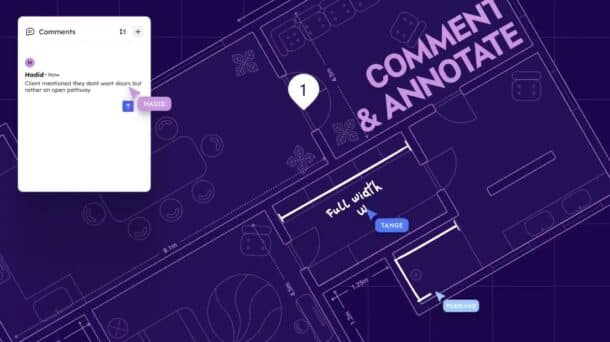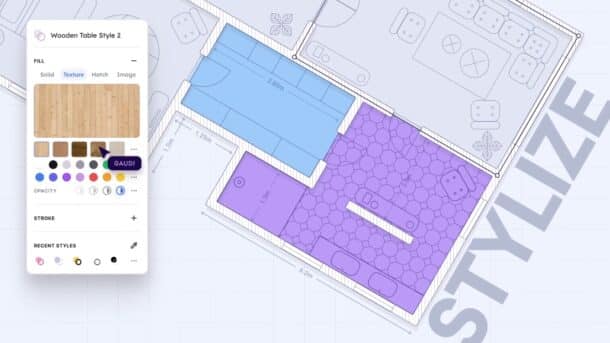In a sea of new BIM upstarts from Snaptrude to Quonic, Architosh became aware of French-based AEC software startup Rayon, thanks to veteran CAD industry journalist Ralph Grabowski.
The new Rayon has financial backing from angel investors, including British starchitect Lord Norman Foster (Foster + Partners) and folks like David Basulto (ArchDaily).
What is Rayon?
Rayon is, ironically, the anti-BIM solution to the, perhaps, the Open Revit Letter. More precisely, the new modern web-based AEC CAD tool addresses “an urgent need for something more accessible than existing BIM tools, yet more power than CAD software when it comes to collaborating, sharing assets, and crafting beautiful drawings.”
Rayon aims to address the “working together” part in the manner of how Figma and Miro has transformed user interface design. “We have made it our mission to bring about the same revolution to the Architecture, Engineering, and Construction (AEC) industry,” the company writes in a post on its latest seed round.
Well Funded
Rayon’s latest seed round was EUR 4 million, led by Northzone and existing earlier investors Fundamental and Seedcamp. The company is two years in the making and has transitioned from a closed beta to an open beta with a developer staff in the mid-teens (in number—not their age!)
Rayon in Action
Rayon’s developers are calling it “light-BIM,”—suggesting strongly that BIM in its current state is too heavy for what a large part of the industry actually needs and that BIM is largely inaccessible to too many AEC stakeholders who need to access data for pointed tasks such as quantification of objects and generating scheduled data into Excel spreadsheets.

Rayon has been seeded to the tune of EUR 4 million, which is a solid war chest of capital for an upstart addressing modern AEC CAD in the cloud.
Rayon works by importing relevant data in the form of DWG, DXF (AutoCAD) files, PDFs, or image files. Or you simply start with a blank canvas. The user then is given a solid first-stage set of core CAD tools for creating, editing, and managing elements like walls, doors, windows, and furniture.
Now in traditional legacy CAD tools, once drawings are ready to share, they are often printed or exported to PDF files for emailing to stakeholders. This is where legacy tools do not tend to leverage the Cloud Era dictates and advantages of modern life. Rayon addresses this with Live Chat and Comments, Annotations and Revisions, and One-Click Link Sharing.
Architosh Analysis and Commentary
Rayon looks like an interesting new AEC industry upstart. The company has smartly recognized that there is a big hole in the current Revit-dominated BIM-centric thinking in AEC worldwide. And that hole is about the fact that the philosophy of “always use the right tool for the job”—something dads especially teach children at a young age—has largely been BIM-washed away.
BIM is not the best choice for every task or every AEC industry project. This is partly why the legacy CAD star AutoCAD has stubbornly continued to thrive and even grow. It is why AutoCAD challengers like BricsCAD and Graebert’s ARES have established massive audiences of users around the world.
However, Rayon’s “light-BIM” philosophical term could be perceived as a tad bit misleading, selecting the word “BIM” over “CAD” when in fact, Rayon seems aimed at modern Cloud Era AEC CAD (CEA-CAD….pronounced see-CAD).
Rayon’s argument reminds me of the AEC industry realism comments from former Vectorworks CEO Sean Flaherty (also former Chief Strategy Officer, Nemetschek Group) and current Chairman, Board of Advisors at Chaos. Those comments made in numerous Architosh interviews in years past foretold of the complexities in BIM adoption and BIM limitations, an argument well-suited at the time for market-leading hybrid BIM-CAD tool Vectorworks. Then as in now, Vectorworks has often been equated with the comment, “if Adobe made a CAD tool, it would be Vectorworks.”
If Rayon is the new kid on the block attacking the “pure BIM school” in AEC, then Vectorworks must be the oldest kid on the block, most capable of leveraging this new moment we might label the “light-BIM school” in AEC. What appears to be shaping up in the BIM 2.0 era is that the BIM era is under assault on multiple sides, with criticisms coming from all angles, from a lack of true “open BIM” to an attack on the inappropriateness of a large single BIM being terribly ineffective in addressing specific industry needs. And finally—and perhaps the biggest attack on the BIM era—its legacy and limiting attachment to the Desktop Era technology stack, most exemplified in Revit.



